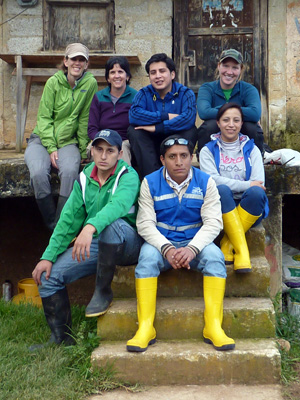
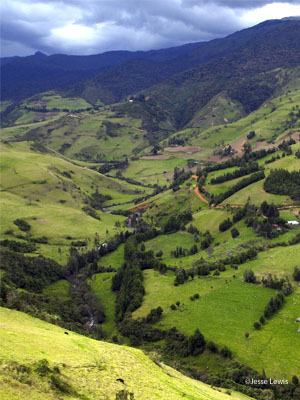
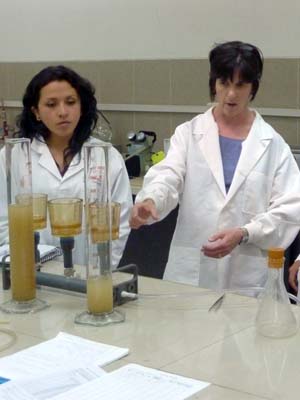
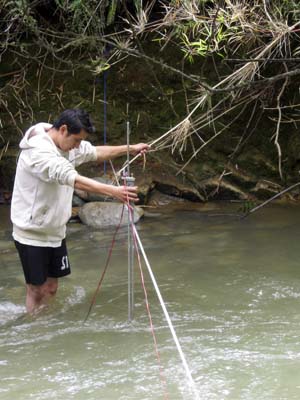
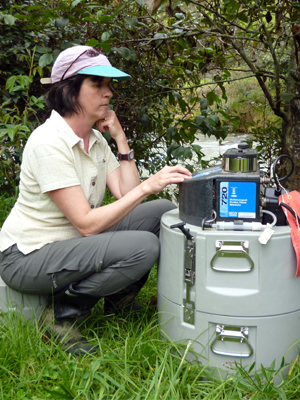
Mazar River Project

Fundación Cordillera Tropical proudly presents our multi-year hydrological monitoring initiative, the Mazar River Project, which seeks to generate information about stream flow and sediment to inform watershed management in the high-mountain areas of southern Ecuador. Launched in 2014, the Project is a collaboration between the Fundación Cordillera Tropical, the University of Vermont, and public hydroelectric companies in Ecuador. It includes three major initiatives: 1) scientific research on stream flow and sediment transport; 2) capacity building for Ecuadorian University students and professionals; and 3) interventions to reduce erosion of sediment off nearby landscapes.
Research
The Mazar River Project established a hydrological monitoring station in southern Ecuador on the Mazar River, a tributary of the Paute River Basin, situated on the eastern Andean cordillera. The station is equipped with sensors to continuously monitor stream stage and turbidity and an automated sampler for event-based collection of stream water samples, providing high frequency data that reduces the uncertainty of observations. During its first 3 years of observation, the program has generated continuous observations of runoff and turbidity. The data is being used to establish relationships between turbidity and concentrations of total suspended solids (TSS), and provide estimates of annual water yield and annual loads of TSS.
The Mazar River Project involves university students, decision makers at hydroelectric companies and professionals, in joint training opportunities with the ultimate goals of (i) monitoring Andean stream flow and sediment transport; (ii) communicating results to scientific and general audiences; and (iii) training a new generation of Ecuador university students in study design, stream monitoring, and data analysis. In May 2015, lead researcher Beverley Wemple of the University of Vermont trained students at the Sallesian Polytechnical University of Cuenca to analyze sediment in water samples. One of the students later went to the University of Vermont in September 2015 to visit the long-term Lake Champlain monitoring initiative run by University of Vermont researchers.
Interventions to reduce sediment transport
In the Paute watershed of southern Ecuador, studies show that ranching and agriculture contribute 52 tons of sediment per hectare per year to local water bodies. Managing this sediment is costly. One local hydroelectric company reports dredging 2.5 million m3 of sediment per year from its reservoirs. Sediment also decreases the useful life of turbines and other components used to generate hydraulic energy. Fundación Cordillera Tropical is working to implement improved cattle ranching techniques that decrease sediment movement across the landscape and into adjacent watercourses. By incorporating trees into grass pastures and using them to form terraces and protect stream channels, this work seeks to decrease sediment transport and protect stream corridors. We also aim to bring attention to other sources of erosion and water quality impacts, including road building and new infrastructure development, which can be addressed through erosion control measures.
FCT has committed to making data from this initiative available for interested researchers. Although some data years are incomplete, we publish here all weather and rainfall data collected beginning in August 2014. Ongoing data collection will be published annually.
Mazar River Discharge 2014 / 2015a / 2015b / 2016
Precipitation
La Libertad 2014 / 2015 / 2016
Mesapata 2014 / 2015 unverified
Weather at La Libertad 2014 / 2015* Weather station breaks and is uninstalled in May 2015.
Notes: To open these data sets, please download the .txt document to your computer. Open an Excel or Open Office spreadsheet and choose the menu “data” and the option “import document from text”. The data is tab delimited and you should correctly format the date column.
Available reports and studies about the Mazar watershed
Buytaert, W., Celleri, R., Willems, P., De Bièvre, B., & Wyseure, G. (2006). Spatial and temporal rainfall variability in mountainous areas: A case study from the south Ecuadorian Andes. Journal of Hydrology, (329), 413-421.
Guallpa, M. & R. Célleri. (2013). Efecto de la estimación de la presión atmosférica sobre el cálculo de niveles de agua y caudales. Aqua-LAC, 5(2), 56-68.
Hampel, H., Cocha, J., & Vimos, D. (2010). Incorporation of aquatic ecology to the hydrological investigation of ecosystems in the high Andes. Grupo de Ciencias de la Tierra y del Ambiente, Universidad de Cuenca.
Hampel, H. (2011). Informe Final: Determinación de los efectos de las variables ambientales sobre las comunidades de organismos acuáticos. Cuenca, Ecuador: Grupo de Ciencias de la Tierra y del Ambiente, Universidad de Cuenca.
Hartsig, J. (2011). The Effects of Land-Use Change on the Hydrological Properties of Andisols in the Ecuadorian Páramo (Master's thesis). The University of Tennessee, Knoxville, Tennessee.
Lozano, J. (2011). Impacto del cambio de coberturas en el rendimiento hídrico y la retención & producción de sedimentos en 5 subcuencas de la cuenca baja del Río Paute: análisis de escenarios utilizando el modelo InVEST. Cali, Colombia: The Nature Conservancy.
Thompson, S. (2011). Análisis histórico de la cobertura del suelo de la subcuenca del bajo río Mazar. Cuenca, Ecuador: Fundación Cordillera Tropical.
Our donors
The Mazar River Project receives generous support from Ecuadorian and International funders, as well as in-kind support from the University of Azuay, the Sallesian Polytechnical University of Cuenca, and a corps of dedicated volunteers and international advisors. The Fundación Cordillera Tropical thanks the University of Vermont, CELEC EP HidroAzogues, FONAPA, the Mazar Wildlife Reserve, the Overbrook Foundation and the Fulbright Program for their valuable contributions.